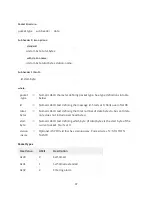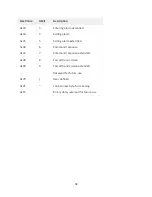
36
APPENDIX B
– IRIDIUM TRANSMISSION HEADER
This appendix describes the content and format of the header included in all Iridium
transmissions (so long as “Include Header” is selected in the setup).
The Facts
Iridium modem buffers are limited in size, forcing software to limit the length of messages it can
send at any one given time. If messages are allowed to exceed these buffer lengths, then multiple
transmissions must be made to send a complete message. These messages include self-timed and
alarm reports, command responses, file data, and log data. The 7/8310 has the requirement that it
reply with command responses over Iridium as soon as the command is processed, which, given
the way the 7/8310 does message checking, may occur between two halves of a self-timed
transmission. In this scenario, the receiver will receive "interleaved" partial responses.
While packets of different types may "interleave" as described, the assumption is the packets of
any given message will always arrive "in order" relative to each other (and, if not, the MOMSM
number w/in the Iridium Gateway header can be used to determine order).
The Issues
The above raises the following questions:
•
How does the receiver identify the scope of a packet (i.e., is the packet a complete
message or only a partial)?
•
How does the receiver differentiate between self-timed, alarm, and command response
transmissions?
•
How does the receiver know how to "stitch" together "interleaved" partial responses (e.g.,
partial self-timed followed by command response followed by remaining self-timed)?
•
How do we transfer log and file data?
The Solution
The solution is to use a header and optional sub-header to identify the content of the message
such that the receiver would be able to reassemble packets. Here are the characteristics of the
header and sub-header:
•
The header uses a single byte in the ASCII printable range to make it easy for humans to
interpret the content
•
The header byte identifies the packet type in terms of the content of the packet, e.g., self-
timed, self-timed extended, entering alarm, entering alarm extended, etc. The "extended"
types mean multiple packets are required to transmit the entire message.
•
The extended packet types include a comma-delimited sub-header to describe the subset
of data being sent. The first sub-header differs from all subsequent sub-headers, in that it
includes the total size of the data being sent.
•
A sub-header is also included when user indicates the station name should be included in
the transmission



































